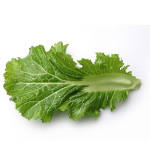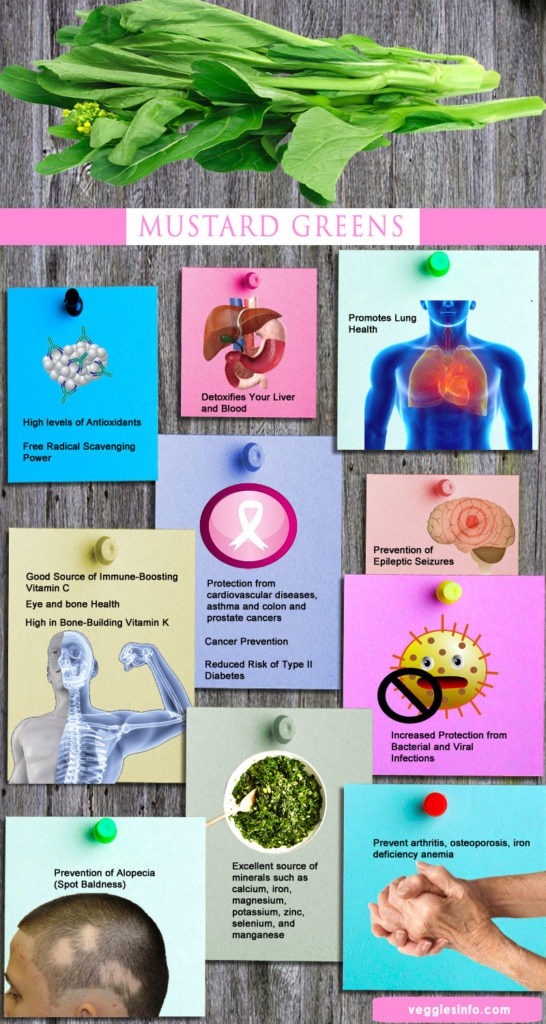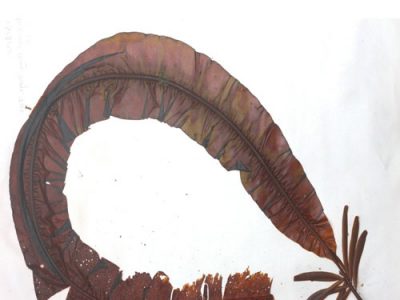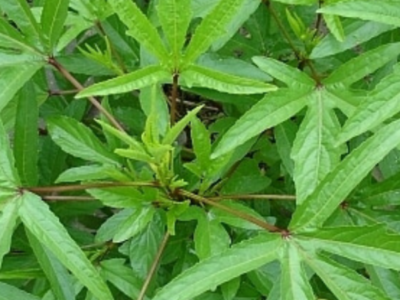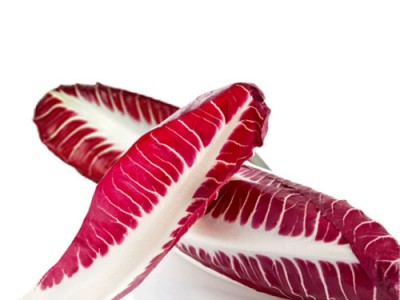
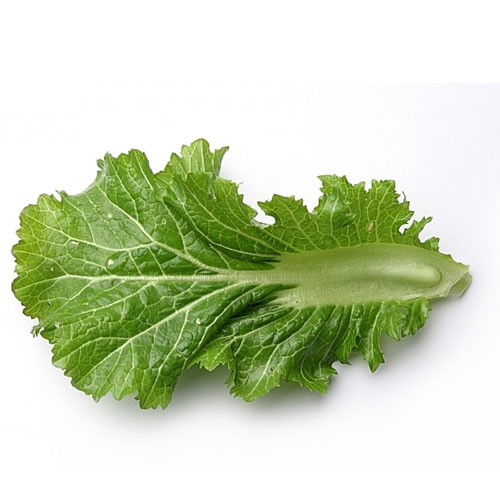
Mustard greens Nutrition and Beneficial Properties
About Mustard Greens
Scientifically known as Brassica juncea; mustard greens belong to the brassica genus and the family of brassicaceae. It is commonly known as brown mustard, Chinese mustard, Indian mustard, leaf mustard, Oriental mustard and vegetable mustard. It looks a lot like kale a headless cabbage and belongs to the cruciferous plant category. It has a distinctive flavour that sets it apart from the rest of its relative plants; the zesty flavour similar to that of a horseradish. It is popularly also known as mustard cabbage. Thick crunchy mustard greens are fast growing plants ideally planted during winters and fall. These plants require rich fertile soil that helps them grow better and the ideal climate for them would be places where it is moderately cold. Even though a little frosting will only make their leaves sweeter; mustard greens are not as strong as their counterparts like kale to withstand extremely cold temperature. Mustard greens are tolerant to shade and during winters they can be grown in green houses. These leaves shoot up to the size of 15 -20 inches within a span of 4 – 6 weeks. Mustard greens do not face any major problems growing into leafy vegetables but sometimes they are attacked by cabbage worms in the garden; club root is another disease that plagues the cabbage family and mustard; timely care needs to taken in order to ensure go health of the plant. Resorting to timely soil check and use of organic pesticides will yield good results
Mustard Greens Nutrition Value
- Excellent source of minerals such as calcium, iron, magnesium, potassium, zinc, selenium, and manganese.
- Prevent arthritis, osteoporosis, iron deficiency anemia.
- High in Bone-Building Vitamin K.
- Good Source of Immune-Boosting Vitamin C.
Mustard Greens Benefits
- Prevent arthritis, osteoporosis, iron deficiency anemia.
- Protection from cardiovascular diseases, asthma and colon and prostate cancers.
- Cancer Prevention.
- High levels of Antioxidants.
- Eye and bone Health.
- Free Radical Scavenging Power.
- Promotes Lung Health.
- Detoxifies Your Liver and Blood.
| Principle | Nutrient Value | Percentage of RDA |
|---|---|---|
| Energy | 27 Kcal | 1% |
| Carbohydrates | 4.67 g | 3.6% |
| Protein | 2.86 g | 5% |
| Total Fat | 0.42 g | 2% |
| Cholesterol | 0 mg | 0% |
| Dietary Fiber | 3.20 g | 9% |
| Vitamins | ||
| Folates | 12 µg | 3% |
| Niacin | 0.800 mg | 5% |
| Pantothenic acid | 0.210 mg | 5% |
| Pyridoxine | 0.180 mg | 14% |
| Riboflavin | 0.110 mg | 8% |
| Thiamin | 0.080 mg | 7% |
| Vitamin A | 3024 IU | 101% |
| Vitamin C | 70 mg | 117% |
| Vitamin E | 0 mg | 0% |
| Vitamin K | 257.5 µg | 215% |
| Electrolytes | ||
| Sodium | 20 mg | 1.3% |
| Potassium | 384 mg | 8% |
| Minerals | ||
| Calcium | 115 mg | 11.5% |
| Copper | 0.165 mg | 18% |
| Iron | 1.64 mg | 20% |
| Magnesium | 32 mg | 8% |
| Manganese | 0.480 mg | 21% |
| Selenium | 0.9 µg | 1.5% |
| Zinc | 0.25 mg | 2% |
| Phyto-nutrients | ||
| Carotene-ß | 1790 µg | — |
| Crypto- xanthin-ß | 40 µg | — |
| Lutein- zeaxanthin | 3730 µg | — |
Mustard greens may not be as rich in vital nutrients as other cruciferous plants but its health benefits cannot be over looked. Mustard greens are rich in phytonutrients a compound derived from plants. These mustard greens are rich in anti oxidants that helps in detoxifying the body and getting rid of the toxic content. The anti oxidants present as vitamin C, vitamin E and Vitamin A each helps the body in building a good immune system while contributing their share in making a healthy body. Vitamin A is responsible for a healthy vision; aging adults should eat mustard greens to have a better eye sight. Vitamin C is known for aiding good skin and hair. Cruciferous plants are known for their properties to prevent cardiovascular diseases. They are rich in anti oxidant properties and lower the risk of blood pressure. They also keep a check on the blood sugar levels of the body hence promoting a good heart health.Cruciferous plants like kale, cabbage and mustard greens are a rich source of oxalates. These compounds are a strict no-no to every individual that is diagnosed with kidney ailments. One needs to refer a doctor and check if the consumption of mustard greens is advisable for their body type.Free-radicals liable for resulting in smooth muscle contraction as well as airway constraint within asthma sufferers get neutralized by the vitamin C contained in the mustard greens. Furthermore, Vitamin C aids in the breakdown of an inflammatory chemical substance, histamine that is overproduced in people struggling with asthma. Moreover, the magnesium content likewise helps relax the bronchial tubes and lungs. The well-being of asthma sufferers who include mustard greens within their diet are noticed to get enhanced medical conditions when compared to the various other asthma patients.
How To Enjoy Mustard Greens
Mustard greens are a good addition to salads as they are high in nutrition and taste good with a crunch to it. Mustard greens can be cooked in Cantonese style by blanching them and serving them with rice or other accompaniments.
Italian twist to mustard greens would be ravioli filled with mustard greens along side with cheddar cheese and bell peppers. These are a few of the possible ways in which mustard greens can be prepared in.

